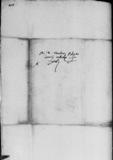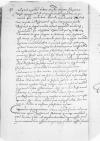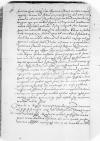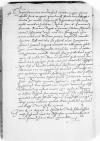List #151
Stanisław HOZJUSZ (HOSIUS) do Ioannes DANTISCUSVilnius, 1541-10-01
| odebrano Heilsberg (Lidzbark Warmiński), 1541-10-17 Rękopiśmienne podstawy źródłowe:
Publikacje:
| ||||||
Tekst + aparat krytyczny + komentarzZwykły tekstTekst + komentarzTekst + aparat krytyczny
Reverendissimo in Christo Patri et Domino, domino
Reverendissime in Christo Pater et Domine, domine colendissime.
Officiosissimam servitutis commendationem.
Quae de Alexandro scripta sunt a
Quae in  BCz, 1618, p. 488 (436) misereatur nostri.
BCz, 1618, p. 488 (436) misereatur nostri.
Serenissima
Qui et Vestram Reverendissimam Dominationem diu servet etc.
Eiusdem Reverendissimae Dominationis Vestrae servitor deditissimus
Item die 16 17 mensis Augusti ab exploratoribus nostris certo edocti sumus imperatorem Turcarum in propria persona priori exercitui appropinquare ipsumque exercitum cotidie novis militum accessionibus augescere ita, quod circiter 70000 virorum excesserunt. Nostri consilium ceperunt relictis stationibus Danubium traicere et ad Pest sese cum tormentis bellicis conferre.
Item die 18 Augusti sex maiora tormenta ad Pest traducta sunt. Eodem quoque die maior pars Hussaronum et Germanorum equitum ad Pest pervenit.
Item die 19 Augusti alia tormenta, globi et multi equi per totum diem ad Pest traducti sunt donec approximante vespera, cum Turcae nostros lacessendo ad arma provocarent, tres Hussarones ex nostratibus ad Turcas profugiendo omnia nostra consilia de fuga ineunda, de relinquendis stationibus eis aperierunt.
Item die 20 Augusti summo mane antequam illucesceret, coeperunt Turcae in duobus locis et Turcae Baltenth a tertia parte, stationes nostras oppugnare. Prima occupatio facta est navali proelio in aggere quodam seu insula, quam Danubius alluit. In ea habuimus 6 tormenta maiora et classes etiam armatas penes eam ipsam insulam, in quas Turcae magna vi irruendo usque ad Pest fugam inire coegerunt. Intercepta est insula ab hostibus simul cum curribus et tormentis, caesi praesidiarii milites circiter 700. Postea interceperunt pontem, qui ab insula protendebatur ad Romanorum stationes. Ibi circiter 12000 Turcarum
 BK, 222, p. 94
reliquis auxilium daturi terrestri itinere advenere. Mox oppugnatum est propugnaculum quoddam, in quo circiter 400 ceciderunt. Deinde coadunatis viribus uno impetu in Bohemorum castra irruptione facta Bohemos in fugam coactos castris exuerunt multosque trucidarunt. Ex classibus Thurcicis, quae insulae nostrae imminebant, magno fragore in stationes nostras sagittatum est. Mox ex Pest protracta sunt duo magna tormenta, quorum iaculationibus in primis tres, mox quinque galeas Turcicas concussas et demolitas una cum hominibus eis insidentibus, aquarum fluctibus subiecerunt praecipitaruntque. Inde metu perculsi Turcae in fugam coguntur. Quos nostrae classes insequuntur, globorum iaculationibus infestant, duas nassadas hostiles capiunt et Turcis in fugam actis insulam una cum tormentis et curribus recuperavere.
BK, 222, p. 94
reliquis auxilium daturi terrestri itinere advenere. Mox oppugnatum est propugnaculum quoddam, in quo circiter 400 ceciderunt. Deinde coadunatis viribus uno impetu in Bohemorum castra irruptione facta Bohemos in fugam coactos castris exuerunt multosque trucidarunt. Ex classibus Thurcicis, quae insulae nostrae imminebant, magno fragore in stationes nostras sagittatum est. Mox ex Pest protracta sunt duo magna tormenta, quorum iaculationibus in primis tres, mox quinque galeas Turcicas concussas et demolitas una cum hominibus eis insidentibus, aquarum fluctibus subiecerunt praecipitaruntque. Inde metu perculsi Turcae in fugam coguntur. Quos nostrae classes insequuntur, globorum iaculationibus infestant, duas nassadas hostiles capiunt et Turcis in fugam actis insulam una cum tormentis et curribus recuperavere.
Ceciderunt eo in loco circiter 500 Turcae exceptis his, qui aquis absorpti sunt aut soli in Danubium sese in praecipites dedere. Tormenta quae in insula habebant, ita erant a Turcis oppleta, ut per integri diei decursum ad nullum sagittandi usum essent idonea. His peractis Bohemorum stationes et propugnaculum illud, cuius supra memini, per Bohemos Germanosque rursus vi intercipitur et caesis circiter 400 Turcis et reliquis in fugam actis, duo tormenta minora in nostram potestatem rediere.
Secundam oppugnationem Turcae coeperunt facere cum 12000 virorum apud Hussaronum stationes, quorum consilium cum Perenni Peter ab exploratoribus cognovisset, quod in eo nimirum loco essent irruptionem facturi, iussit planitiem
 BK, 222, p. 95
magnam pulvere incendiario ex octo tunnis deprompto conspergere et conspersam stramine contegere. Cum itaque antelucano tempore Turcae magnis et horrendis clamoribus ad oppugnationem praecurrerent, nostri a sagittando paulisper sibi temperarunt, donec ab hostibus in eum locum vocatum est, ibi accenso pulvere hostes omni ex parte armis et sagittationibus profligantur. Ex hostibus caesi sunt circiter 1200, reliqui fuga dilapsi.
BK, 222, p. 95
magnam pulvere incendiario ex octo tunnis deprompto conspergere et conspersam stramine contegere. Cum itaque antelucano tempore Turcae magnis et horrendis clamoribus ad oppugnationem praecurrerent, nostri a sagittando paulisper sibi temperarunt, donec ab hostibus in eum locum vocatum est, ibi accenso pulvere hostes omni ex parte armis et sagittationibus profligantur. Ex hostibus caesi sunt circiter 1200, reliqui fuga dilapsi.
Tertiam oppugnationem magna vi fecit Turek Valenth in monte sancti Gerardi et minimo suo periculo copias suas traduxit usque ad crucem superinscribed in place of crossed-out montem⌈montem crucem crucem superinscribed in place of crossed-out montem⌉, quae sub monte consistit. Inde sagittando multa clade nostros affecit, donec in Pest apud Palum in loco publico producta sunt duo tormenta, e quibus trans Danubium sagittarunt nostri adversus hostes, quos tamen reprimere non valuerunt, quosque denuo feliciore eventu sagittatum est, bis adversus hostes et semel versus montem sancti Gerardi. Hinc Turcae in fugam coniciuntur, globorum ictibus et nostrorum armis circiter 400 hostes periere.
Item dies 21 Augusti usque ad noctem ms. aam(!)
⌈ad noctemad noctem ms. aam(!)
⌉ ipsam consumptus est traiciendis ad Pest hominibus, equis, curribus, globis et tormentis, et hominum traiectus fere ad mediam usque noctem duravit, donec maior paene hominum pars fuerat transvecta. Sub id tempus coeperat Monachus acriter Danubium sagittando et nostra remigia ferire exstructo igne apud stabulum regium, qui omnem illam Danubii oram suo fulgore depulsis tenebris collustravit. Deinde ex turri aquatica proiectus est in stationes nostras globus igneus, qui easdem stationes succendit. Interea temporis nihilominus nostri conabantur quique pro se summo studio amnem traicere et trium fere
 BK, 222, p. 96
horarum spatio antequam dies illuxerat, Turcae montem occuparunt ingenti clamore ad stativa properando quidem, sed tamen aliquamdiu ab eorum direptione sese continendo constructo ibidem magno igne, qui nostratium fugam et traicientium turbam omnibus conspicuum reddidit. Postea interiecto fere duarum horarum intervallo ante diem adventantem, Turcae in stationes nostras irruptionem faciunt, quas ab omnibus destitutas ac derelictas invenerunt. Etenim ad Danubium confugerat quicquid hominum reliquum fuit. Nostri a Turcis vi praepediuntur, quominus fluvium traicere poterant. Bohemi, Hussarones et Germani, quid adhuc supererant, collectis viribus retro rupem quandam constituto firmo propugnaculo strenue certantes usque ad primam diei horam hostium vim et impetum umeris suis sustinuerunt, donec ad unum omnes caesi sunt. Desiderantur autem quantum ex conscriptorum numero colligitur circiter 6000 fortissimorum virorum, qui partim caesi, partim aquis absorpti sunt. Iam itaque in duabus horis ab exorto sole omnia nostratium castra hostilis manus occupavit, in quibus reperta sunt 40 tormenta campestria exceptis arkabuzi ac mortariis, 50 vasa pulveris, magna vis globorum ferreorum, pontes navigiorum, tentoria, naves, currus onerarii multis opibus referti ipsis proceribus pertinentes, quin etiam in ipsa insula sex maiora tormenta relicta sunt.
BK, 222, p. 96
horarum spatio antequam dies illuxerat, Turcae montem occuparunt ingenti clamore ad stativa properando quidem, sed tamen aliquamdiu ab eorum direptione sese continendo constructo ibidem magno igne, qui nostratium fugam et traicientium turbam omnibus conspicuum reddidit. Postea interiecto fere duarum horarum intervallo ante diem adventantem, Turcae in stationes nostras irruptionem faciunt, quas ab omnibus destitutas ac derelictas invenerunt. Etenim ad Danubium confugerat quicquid hominum reliquum fuit. Nostri a Turcis vi praepediuntur, quominus fluvium traicere poterant. Bohemi, Hussarones et Germani, quid adhuc supererant, collectis viribus retro rupem quandam constituto firmo propugnaculo strenue certantes usque ad primam diei horam hostium vim et impetum umeris suis sustinuerunt, donec ad unum omnes caesi sunt. Desiderantur autem quantum ex conscriptorum numero colligitur circiter 6000 fortissimorum virorum, qui partim caesi, partim aquis absorpti sunt. Iam itaque in duabus horis ab exorto sole omnia nostratium castra hostilis manus occupavit, in quibus reperta sunt 40 tormenta campestria exceptis arkabuzi ac mortariis, 50 vasa pulveris, magna vis globorum ferreorum, pontes navigiorum, tentoria, naves, currus onerarii multis opibus referti ipsis proceribus pertinentes, quin etiam in ipsa insula sex maiora tormenta relicta sunt.
Item die 22 Augusti universus populus, qui amnem traiecerat, ad Pest sese recepit. At ubi intellexerat Turcas magna vi on the margin⌈vivi on the margin⌉ nostros adortos esse, rursus e civitate profugiunt, tantus pavor eorum mentibus insederat, et cum a civitate paulo remotius abessent, mox quasi novo coorto tumultu in civitatem
 BK, 222, p. 97
agminatim recurrunt, ut fugiendi et retrocedendi nullus esset neque finis neque modus. Tanto metu, tanta trepidatione agitabantur miseri, ut nulla oratione digne explicari queat. Nulli a superinscribed⌈aa superinscribed⌉derant duces, nulli capitanei, qui fugientes subsistere et trepidantibus animum addere aut voluissent aut potuissent. In fuga extremum erat praesidium. Rursus ante meridiem unius fere horae spatio, liberum erat omnibus, qui vellent civitate excedere. Ibi cernere erat turbas effusis portis in fugam ruentes tanta densitate, ut plerique compressi animam exhalarint. Multi ex equitibus peditibusque fuga dilapsi sunt, quos insequebantur currus alias koczi. Et postremo loco Hussarones Newesorenth pertinentes. Sub haec praesidiarii Budenses 6 nassadis advecti per Danubium in civitatem irruperant ab ea parte, quam non ita pridem Turcae sagittando conquassaverunt et tumultu excitato plerosque interemerunt. Ac circiter Hussarones 800 cum nonnullis pixidariis re cognita in civitatem reversi clamore ingenti per omnes vicos et plateas concitato Budenses extra urbem propulsant et ad suas nassadas coegerunt redire.
BK, 222, p. 97
agminatim recurrunt, ut fugiendi et retrocedendi nullus esset neque finis neque modus. Tanto metu, tanta trepidatione agitabantur miseri, ut nulla oratione digne explicari queat. Nulli a superinscribed⌈aa superinscribed⌉derant duces, nulli capitanei, qui fugientes subsistere et trepidantibus animum addere aut voluissent aut potuissent. In fuga extremum erat praesidium. Rursus ante meridiem unius fere horae spatio, liberum erat omnibus, qui vellent civitate excedere. Ibi cernere erat turbas effusis portis in fugam ruentes tanta densitate, ut plerique compressi animam exhalarint. Multi ex equitibus peditibusque fuga dilapsi sunt, quos insequebantur currus alias koczi. Et postremo loco Hussarones Newesorenth pertinentes. Sub haec praesidiarii Budenses 6 nassadis advecti per Danubium in civitatem irruperant ab ea parte, quam non ita pridem Turcae sagittando conquassaverunt et tumultu excitato plerosque interemerunt. Ac circiter Hussarones 800 cum nonnullis pixidariis re cognita in civitatem reversi clamore ingenti per omnes vicos et plateas concitato Budenses extra urbem propulsant et ad suas nassadas coegerunt redire.
Postremo cum sex Turcarum naves versus Pest contenderent, coeperunt currus atque testudines diripere, spoliati ac direpti sunt currus, supremi capitanei, comites de Salvi et aliorum multum auri, multum argenteae supellectilis arg ibidem repertum est. Dum haec geruntur Turcarum nassadae appulerunt et in civitatem procurren(tes) or procurren(do)⌈procurren(tes)procurren(tes) or procurren(do)⌉ denuo ab Hussaronibus vi eiciuntur, donec Turcae auctis viribus domus occupare coeperunt, e quibus cum fortiter sagittarent, Hussarones fugae praesidio saluti suae consuluerunt, multa praeda, quam ceperant ibidem, relicta.
Itaque Turcae circa meridiei horam civitatem magno clamore capiunt. Saucii et aegroti, quorum multi fuerant, trucidantur written over runt⌈runtnturntur written over runt⌉, circiter 300 currus diripiuntur. Negotiator{i}um testudines repletae mercibus spoliantur. Relicta sunt ibi 8 maiora tormenta, pecunia regis et pannus solutioni stipendiariorum destinatus. Vasa vini 600, farris vasa 1600, avenae ... illegible⌈...... illegible⌉ 1000, multum pecuniae comparando commeatui deputatae, pulveris tunnae 300, plumbi erunt sexaginta, globorum saxeorum magnus numerus, 200 tela ignea, globi ignei et ut brevibus multa complectar, omnia ad artelaria pertinentia perierunt. Denique feni et pabulorum magna copia ibi relicta est. Nam ad necessitatem hibernarum stationum tanta provisio facta erat, sed Deus aliter disposuit. Ante Pest in Danubio relictae sunt duae naves globis oneratae hidden by binding⌈[ae]ae hidden by binding⌉, item navis una, cui impositum est tormentum, quod vulgo magnae cantatricis cognomen ms. ine(!) ⌈enen ms. ine(!) ⌉ habuit et circiter 400 pulverum tunnae. Apud muros Pestenses similiter 3 tormenta remanserant. Ex nostro exercitu supersunt 9 vexilla peditum Hussaronum 4000, equitum 2000 et 3000 Moravis, qui ibidem militarunt. Vix restant circiter 150 galeae, 10 navigia et bellicae nassadae fere omnes evaserunt. In eisdem residuus exercitus adverso flumine usque ad Freystadst navigavit, ibique primo nocturno quievit. Turcae pabulum, quod praedantes non longe a Vacia spolia egerunt.
Item die 27 Augusti dominus Leonardus a Vels festinatissimo cursu Posonium venit, ut dispersum exercitum colligeret; an id futurum sit, in brevi apparebit.









